
Authors: Puzio K, Delépée R, Vidal R, Agrofoglio LA
Article Title: Combination of computational methods, adsorption isotherms and selectivity tests for the conception of a mixed non-covalent-semi-covalent molecularly imprinted polymer of vanillin.
Publication date: 2013
Journal: Analytica Chimica Acta
Volume: 790
Page numbers: 47-55.
DOI: 10.1016/j.aca.2013.06.036
Alternative URL: http://www.sciencedirect.com/science/article/pii/S0003267013008593
Abstract: A novel molecularly imprinted polymer (MIP) for vanillin was prepared by photo initiated polymerization in dichloromethane using a mixed semi-covalent and non-covalent imprinting strategy. Taking polymerisable syringaldehyde as "dummy" template, acrylamide was chosen as functional monomer on B3LYP/6-31+G(d,p) density functional theory computational method basis with counterpoise. The binding parameters for the recognition of vanillin on imprinted polymers were studied with three different isotherm models (Langmuir, bi-Langmuir and Langmuir-Freundlich) and compared. The results indicate an heterogeneity of binding sites. It was found and proved by DFT calculations that the specific binding of vanillin in the cavities is due to non-covalent interactions of the template with the hydroxyphenyl- and the amide-moieties. The binding geometry of vanillin in the MIP cavity was also modelled. The obtained MIP is highly specific for vanillin (with an imprinting factor of 7.4) and was successfully applied to the extraction of vanillin from vanilla pods, red wine spike with vanillin, natural and artificial vanilla sugar with a recovery of 80%
Template and target information: syringaldehyde, dummy template, vanillin
Author keywords: Molecularly imprinted polymers, Vanillin, adsorption isotherms, Computational structure determination, wine



Join the Society for Molecular Imprinting

New items RSS feed
Sign-up for e-mail updates:
Choose between receiving an occasional newsletter or more frequent e-mail alerts.
Click here to go to the sign-up page.
Is your name elemental or peptidic? Enter your name and find out by clicking either of the buttons below!
Other products you may like:
 MIPdatabase
MIPdatabase









